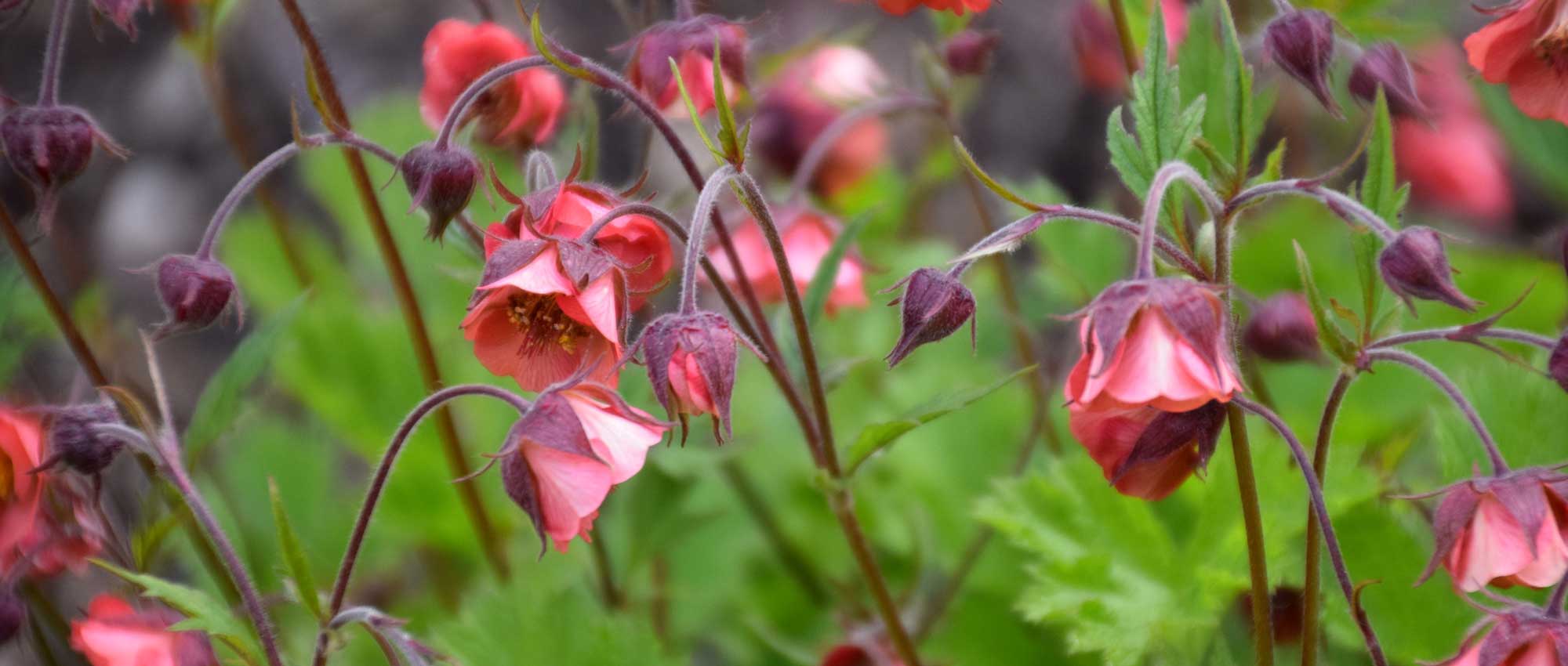
Avens or Geum: planting, growing and care
Contents
Bidens in a nutshell
- Geums offer vibrant flowerings, often in shades of yellow, orange, or red.
- Some varieties have particularly delicate and nuanced flowers.
- Their slender stems and airy flowering bring lightness to the borders!
- Perfect for mixed borders, they easily combine with other perennials.
- Easy to care for, they are completely hardy young plants and not very susceptible to diseases!
A word from our Expert
Avens are lovely perennial plants that offer a splendid colourful flowering at the end of spring and the beginning of summer, in warm tones: orange, yellow, red, cream, sometimes purplish… They have the advantage of bringing both a bright and warm aspect to borders, as well as a great lightness. Discover the vibrant flowering of Geum coccineum or Geum chiloense, particularly the variety ‘Mrs Bradshaw’, renowned for its bright red flowers. With their fine, slender stems bearing flowers in striking colours, avens are perfect for creating bouquets. Moreover, some varieties offer perpetual flowerings!
Rather easy to cultivate, avens are low-maintenance plants. They thrive in partial shade, in cool, well-drained soil. Some, like Geum rivale, are suited to moist soils. They require little care, tolerate competition from other perennial plants well, and can be multiplied by sowing or clump division.
Avens are plants that have been found in gardens for a long time, but have been brought back into fashion with recent cultivars in vibrant colours. The varieties with orange flowers easily fit into contemporary gardens, creating borders with dynamic hues. Their very free habit allows for interesting structural effects, providing a light and airy feel that can, for example, contrast with more upright and rigid forms.
Botany
Botanical data
- Latin name Geum sp.
- Family Rosaceae
- Common name Avens, toothache plant
- Flowering from May to July-August
- Height often less than 60 cm
- Exposure partial shade
- Soil type cool but well-drained, rich in humus
- Hardiness between -15 and -30 °C
The avens are perennial plants that are often rhizomatous, comprising between 30 and 40 species native to Europe, but also to Asia, Africa, and America. For instance, Geum chiloense comes from Chiloé Island, off the coast of Chile. In France, the most common species is Geum urbanum, which grows in hedges and undergrowth, as well as in fallow land. However, other species can also be found, such as the Water Avens (Geum rivale) and the Mountain Avens (Geum montanum). Their species names often indicate the natural habitat from which they originate. Thus, Geum urbanum frequently grows in urban wastelands, Geum rivale thrives in moist soils, particularly along stream banks, and Geum montanum grows at altitude, in meadows and rocky environments. The Geum rivale is protected in several French regions.
The avens are part of the large family of Rosaceae, which includes over 3,000 species. This is the family of roses and most fruit trees (plum, cherry, apple, peach…). The Avens are also cousins to the tormentil and strawberries.
Etymologically, the scientific name Geum comes from the Greek geno and means “to give flavour, to season, to enhance,” as the rhizome has a clove-like scent (it can be used to flavour dishes or drinks). In French, this plant is called Avens to pay tribute to Saint Benedict, the saint who founded the Benedictine order. The Geum urbanum is sometimes referred to as Saint Benedict’s Herb.
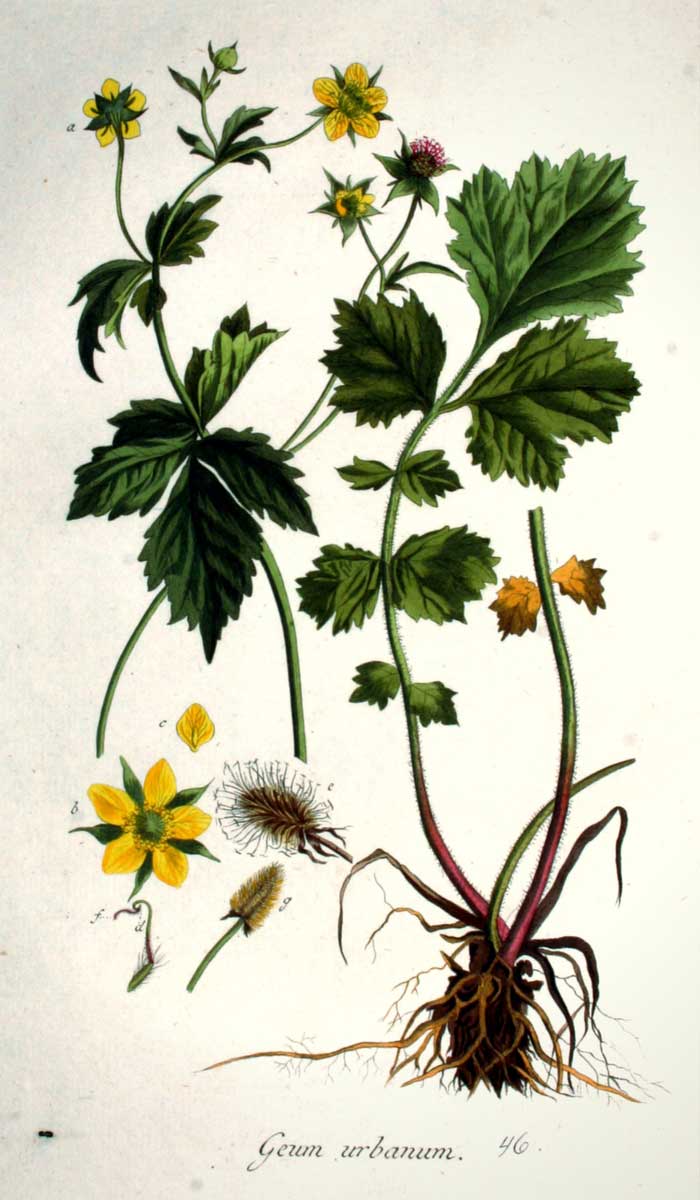
Geum urbanum: Botanical illustration
The avens form a tuft : it consists of a basal rosette of leaves, from which upright and flexible stems emerge, bearing flowers at their tips. These stems are slender and more or less branched depending on the varieties. They are sometimes red-purple, a dark hue that enhances the flowering. The avens are pubescent plants (especially Geum rivale!): the stems, sepals, and the underside of the leaves are often covered with hairs.
The Avens can reach up to 60 centimetres in height. The Geum reptans (creeping avens) and Geum montanum are among the shortest, not exceeding 15 centimetres in height. Some species, such as Geum rivale or Geum reptans, spread by producing stolons (flexible stems that root upon contact with the soil).
The avens bloom from May, and until July-August for most varieties. Those from Geum chiloense bloom a little later, often from June until September. Some avens are particularly interesting for their perpetual flowering! This is the case for ‘Feuermeer’, ‘Mai Tai’, or ‘Flames of Passion’.
The avens bear flowers at the end of long, branched, and slender stems. The flowers can be solitary or grouped in corymbs. Botanical species generally have simple flowers, but there are many varieties with double or semi-double flowers. In Geum urbanum, the flowers consist of five petals, which is characteristic of the Rosaceae family. They are surrounded by five triangular sepals. The petals are sometimes crumpled, as seen in Geum ‘Bell Bank’. The flowers have numerous stamens at their centre, which are often quite decorative.
The flowers measure between 2 and 5 centimetres in diameter. Those of Geum rivale are smaller (up to 2 centimetres in diameter). They are often cup-shaped. The flowers are generally upright but can also be drooping, directed towards the ground, as in Geum rivale.
The avens offer a beautiful diversity of colours! There are many varieties with vibrant blooms: golden yellow, bright orange, or scarlet red… Ideal for adding vitality to a flowerbed! The avens coccineum and chiloense are impressive for their very bright hues! This is indeed what gives the scarlet avens, Geum coccineum, its name. Other species are appreciated for their delicate and light blooms, with much more nuanced shades, such as Geum rivale or Geum ‘Cosmopolitan’.
The foliage of the avens is semi-evergreen. The leaves are often arranged in a basal rosette (attached to the base of the plant) and can measure up to 25-30 centimetres in length. They are divided into more or less large lobes, giving them an irregular appearance. The leaflets are dentate along their edges. Those located at the terminal position are larger than the others. At the base of the petiole (the segment connecting the leaf to the stem), the avens often bear large stipules that resemble leaves. The leaves are generally a bright green. They can also be surprisingly bright, as in the case of Geum ‘Eos’, where they take on a superb golden yellow hue!
The avens form a tuft on a rhizome (a horizontal underground stem), which allows it to spread. In Geum urbanum, this rhizome is used for its aromatic and medicinal properties.
After flowering, the avens bear fruits composed of a large number of rounded and clustered achenes, sometimes feathery. In Geum urbanum, these achenes have small hooks, allowing them to cling to the hairs of animals and disperse.

The fruits and achenes of the Avens: those of Geum urbanum, equipped with hooks / Geum rivale (photo H. Zell) / Geum triflorum (photo Aaron Carlson)
The botanical species
- Geum urbanum
The common avens has beautiful yellow, simple flowers with five petals, and bright green foliage. Its roots and leaves can be used for their medicinal and aromatic properties. It can be found wild in France, in wastelands, hedges, and forest edges.
- Geum coccineum
The scarlet avens, or orange avens, is native to the Balkans. It bears flowers with bright orange petals and yellow stamens. The most common variety is ‘Borisii’. Geum coccineum has also given rise to some original varieties, such as ‘Eos’, which has very bright foliage, almost yellow.
- Geum chiloense
This avens comes from Chiloé Island, off the coast of Chile. Its flowering, from June to September, is a bit later than in other species. The bright red flowers are borne on branched stems. It has large leaves that can reach up to 30 centimetres in length.
- Geum rivale
This is the water avens. It can be found in France near watercourses and in wet areas, mainly in mountainous regions. It bears beautiful cream-orange flowers, tinged with red, and directed towards the ground. The stems and sepals have a beautiful red-brown hue. A more delicate flowering than in other species.
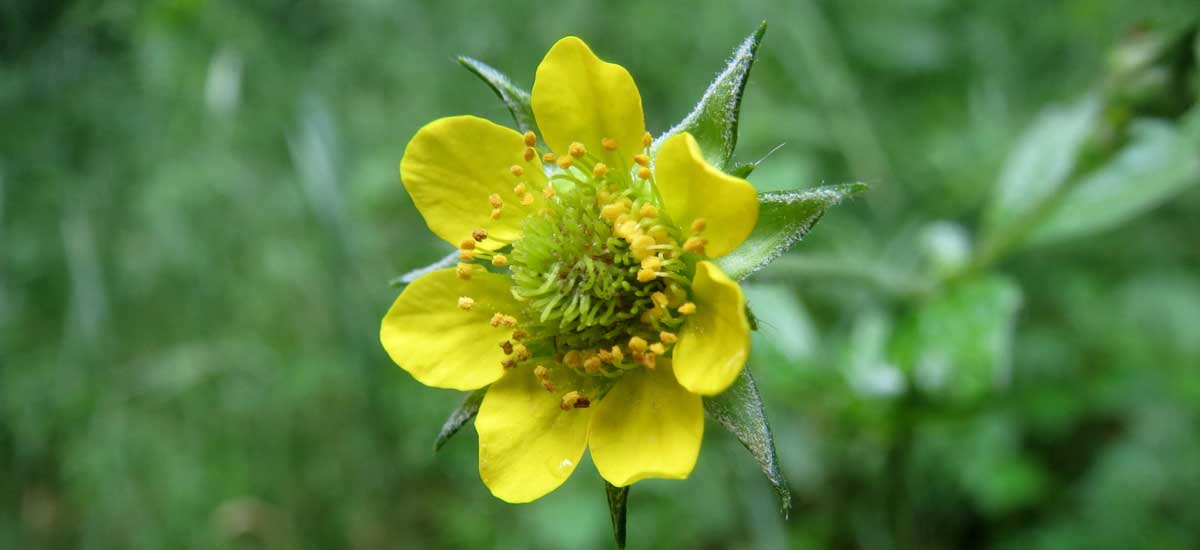
Geum urbanum
The main varieties of Geum
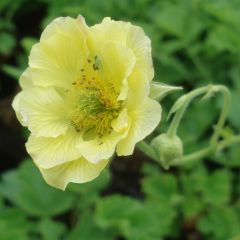
Geum Banana Daiquiri
- Flowering time June to August
- Height at maturity 40 cm
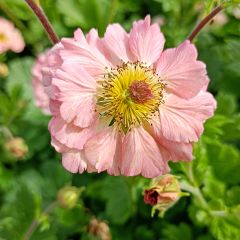
Geum rivale Mai tai
- Flowering time June to September
- Height at maturity 45 cm
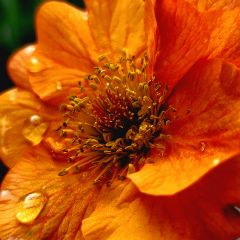
Geum Prinses Juliana
- Flowering time June to October
- Height at maturity 40 cm
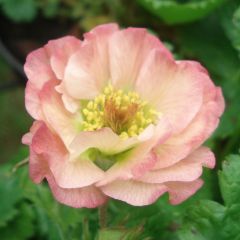
Geum Cosmopolitan
- Flowering time June, July
- Height at maturity 60 cm
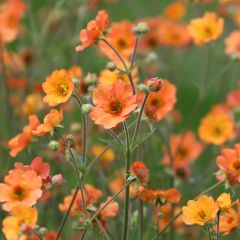
Geum Totally Tangerine
- Flowering time June to August
- Height at maturity 75 cm
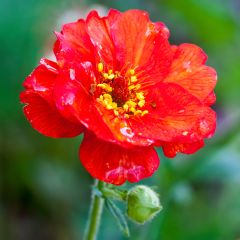
Geum chiloense Mrs Bradshaw
- Flowering time June, July
- Height at maturity 50 cm
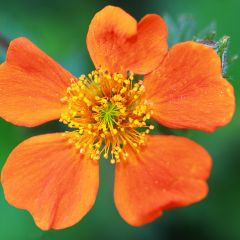
Geum coccineum Borisii
- Flowering time June to October
- Height at maturity 40 cm
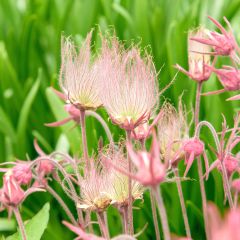
Geum triflorum
- Flowering time June to August
- Height at maturity 50 cm
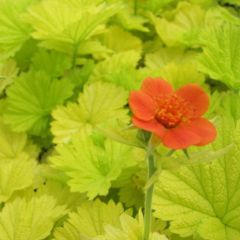
Geum Eos
- Flowering time June to August
- Height at maturity 30 cm
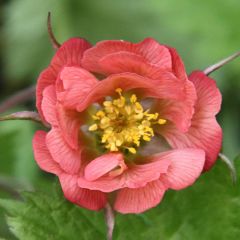
Geum rivale Leonards Variety
- Flowering time June to August
- Height at maturity 45 cm
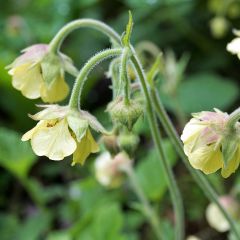
Geum rivale Lemon Drops
- Flowering time June to August
- Height at maturity 25 cm
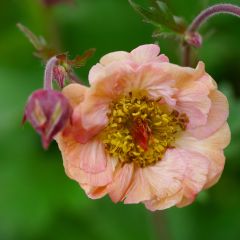
Geum Bell Bank
- Flowering time June to August
- Height at maturity 40 cm
Discover other Geum - Avens
View all →Available in 1 sizes
Available in 2 sizes
Available in 2 sizes
Available in 3 sizes

Available in 3 sizes
Available in 1 sizes
Available in 3 sizes
Available in 1 sizes
Available in 2 sizes
Available in 2 sizes
Planting of the avens
Where to plant?
Ideally, plant the Avens in partial shade, although this also depends on your geographical location: if you live in the north of France, it is better to place it in the sun, while in the south, it will thrive more in the shade. In a warm climate, choose a location that will be shaded during the afternoon. It enjoys good light but does not like scorching sun. Be cautious with varieties that have light foliage, such as ‘Eos’: direct sunlight could scorch its leaves. In this case, prefer a more shaded exposure.
The substrate must be well-drained to prevent water from stagnating in winter and causing the roots to rot. Conversely, Geum rivale prefers moist ground as it grows wild along stream banks and in waterlogged soils.
Plant the Avens in fertile soil that is rich in organic matter. Do not hesitate to add well-decomposed compost at planting time.
The Avens also appreciates neutral or slightly acidic soils. However, it can tolerate calcareous soils.
The Avens is a plant that adapts quite well to mountain gardens, as it has good hardiness. Several species (Geum montanum…) originate from mountainous regions. However, if you live at high altitude, ensure that the substrate is sufficiently drained, as the plant will struggle to withstand the cold if there is also stagnant moisture in winter.
When to plant?
Preferably plant the Avens in spring, around April. It is also possible to do so in autumn, in October or November. Avoid particularly frosty periods.
How to plant?
We recommend planting the Avens in groups of at least three or five young plants, possibly combining different varieties. Maintain a distance of 40 to 50 centimetres between each plant.
- Arrange the plants on the ground to visualise how you wish to place them.
- Dig a hole wide enough and add some well-decomposed compost.
- Plant your Avens, then replace the soil around each clump.
- Lightly firm down with the palm of your hand.
- Water generously.
Maintain regular watering during the first few weeks after planting to ensure good establishment of the plant.
Also, check out our video tips: How to plant perennials?
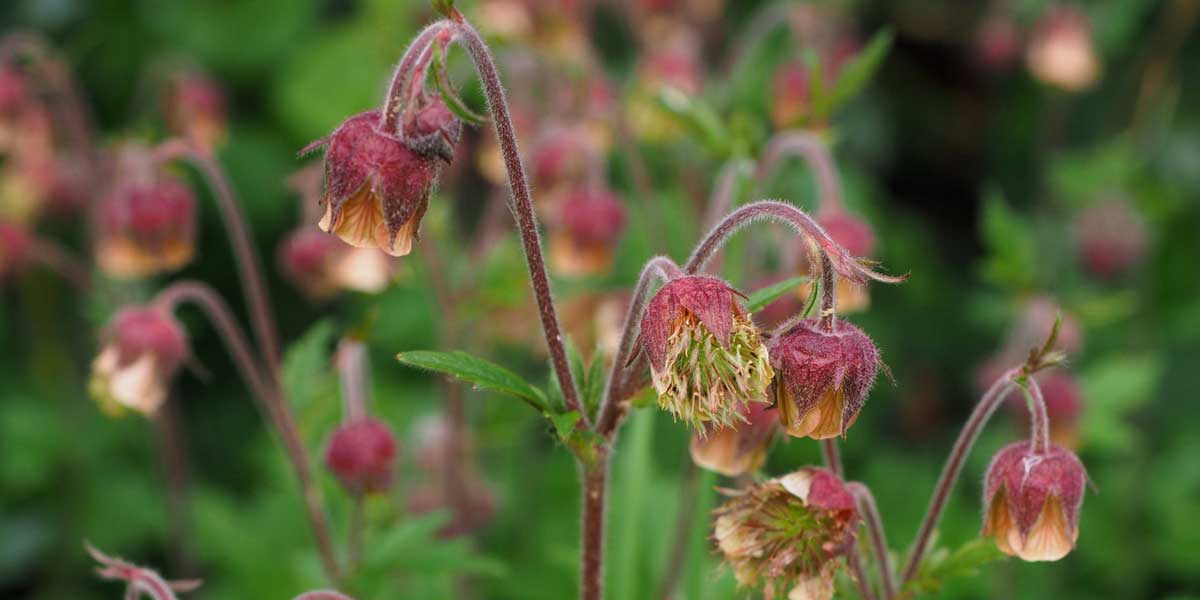
Care
Benedictines generally remain in place for several years without requiring much maintenance. However, we recommend watering in summer and during dry spells, especially in the first year. You need to be more vigilant with the water avens, which requires more moisture. Water it as soon as your soil starts to dry out. We also suggest regularly removing faded flowers to encourage the blooming of new flowers, thus prolonging the flowering period. However, you may choose to leave some on the plant to enjoy the decorative aspect of the seeds, especially in varieties where the achenes are feathery (for example, in Geum triflorum!). In spring, you can also cut back the dried leaves.
It is best to divide the avens every three years. This will rejuvenate and aerate the clumps. You can take the opportunity to plant the new young plants in another part of the garden or give them to friends. Don’t hesitate to stake the taller varieties, especially if they are exposed to winds. You can apply a mulch at the base of the plant in autumn. This way, the soil will stay moist longer, and you will reduce weeding.
The avens (notably Geum urbanum and Geum rivale) tend to spread through their rootstocks and runners. Therefore, you will need to consider containing them by cutting the roots, uprooting some plants, and removing faded flowers to prevent seed dispersal.
The avens are easy-going plants and quite resistant to diseases. They may occasionally be affected by powdery mildew or downy mildew. In damp soil, they are sometimes affected by grey rot. In this case, you should consider moving the plant to a more draining area or adding a layer of gravel. It can also happen that sawfly larvae (Hymenoptera) nibble on the leaves. You can remove them manually and cut away the heavily affected parts of the plant. Then spray with black soap.
Propagation
Sowing
You can sow the seeds of Geums, but germination can be quite erratic. To obtain Geums identical to the original young plant, favour botanical species over horticultural hybrids. Sowing takes place in spring. Sometimes, avens self-seeds spontaneously: take advantage of this to collect the young plants.
- Fill a seed tray with substrate, then lightly firm it down and water.
- Place the seeds on the surface.
- Cover with a very thin layer of substrate.
- Place the seed tray in a sheltered location.
- After one to two months, transplant the young shoots into individual pots.
- Plant in the ground in autumn.
Clump Division
Multiply Geums by division in spring or autumn. We recommend doing this every three years, at least to rejuvenate your plants. This helps to aerate and refresh them, preventing the flowering from becoming exhausted. Start by identifying the densest clumps. Carefully dig around them, then take a young plant with roots by separating it from the main clump. Replant it in a new location (or in a pot), firm it down, and water generously.
Association
Geum are delicate perennial plants, quite low and light. Place them at the front of a flower bed, in front of other more imposing plants. Create a contrast with coarser, less divided foliage, such as heucheras, bergenias, spurge or alchemilla. The geums will add a pleasant touch of colour, beautifully enhancing the flower bed.
They benefit from being planted in groups rather than isolated. Feel free to combine different varieties, as their warm colours will harmonise easily. Use geum to create a lively and bright border with vibrant colours. Pair it with other flowers in warm tones: poppies, yarrow, crocosmias, anthemis, erysimum… These bright shades will bring a lot of vitality to your garden!
Take advantage of the light and airy habit of geum to play with shapes. You can place it at the edge of a flower bed to create a lovely contrast with the straight and well-maintained side of a short grass meadow. In a very structured garden, geum will add an irresistible poetic and delicate aspect! Pair it with pennisetums, meadow rue (Thalictrum), aquilegia or astrantia.
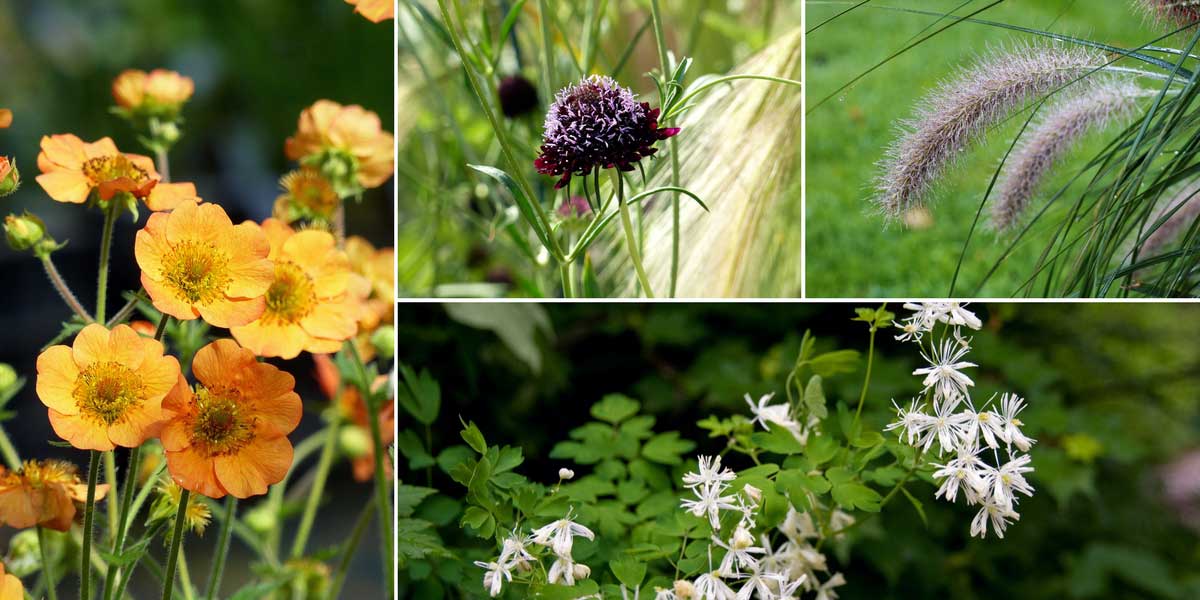
Pair geum with other light blooms! Geum ‘Totally Tangerine’, Scabiosa atropurpurea ‘Chile Black’, Pennisetum alopecuroides (photo Dominicus Johannes Bergsma) and Thalictrum aquilegifolium
Geum easily finds its place in a naturalistic garden, as its fine stems and airy flowering, with a very free habit, give it a wild look! It has a spontaneous appearance that integrates wonderfully into a country-style garden. We recommend planting it alongside grasses, yarrow, poppies or sanguisorba.
Some geum adapt very well to rock garden planting. This is the case for example with the small Geum montanum and Geum reptans. You can also choose the variety ‘Mai Tai’, which is easier to find in cultivation. Pair them with other rock garden plants, such as Arenaria montana, carnations, saxifrages or sedums. In contrast, the geum Geum rivale thrives in moist soils. You can plant it at the edge of a pond, for example with ferns, horsetails, yellow flag iris, Asian primroses…
For a very romantic flower bed, plant your geum at the foot of roses! Choose varieties with delicate blooms: for example, Geum ‘Cosmopolitan’, whose flowers have subtle shades in cream-white to pink tones. Accompany them with other blooms in soft hues: clematis, astrantia, sanguisorba, poppies…

You can plant geum at the foot of roses, alongside other delicate blooms, such as astrantia! Geum ‘Mai Tai’, Rosa ‘Munstead Wood’ and Astrantia major ‘Rosea’
→ Discover more pairing ideas with geum
Did you know?
The uses and properties of common avens (Geum urbanum)
The leaves of common avens are edible, and you can incorporate them into a salad. The root is aromatic and can replace cloves. It is also possible to make avens wine, liqueur, or use the roots to flavour beer. Avens is used for toothache, diarrhoea, and for its antiseptic properties.
Useful resources
-
- Discover our range of avens!
- An article by Ingrid on our blog – The Avens or Geum: a charming perennial to rediscover!
- An inspiration idea for pairing avens: Naturalist Garden Ambience
- Our advice sheet: Geum, how to choose avens?
Frequently asked questions
-
The leaves of my avens are holey and seem to be chewed!
The culprits are likely the sawflies, larvae of hymenopterans that closely resemble caterpillars. They feed on the leaves. To get rid of them, spray with black soap or a treatment based on pyrethrum, after removing and burning the most affected parts of the plant.
-
My Geums are producing fewer and fewer flowers. What should I do?
After a few years, young plants of geums tend to become exhausted. They should then be divided (on average every three years) to aerate the clumps, rejuvenate them, and restore their vigour. Intervene in autumn or spring, ensuring to retain as many roots as possible on each plant taken. Replant in another location and water.
- Subscribe!
- Contents




































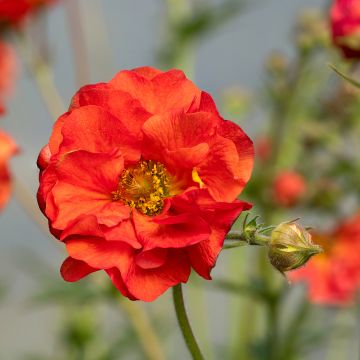
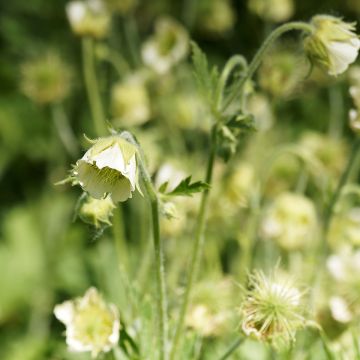
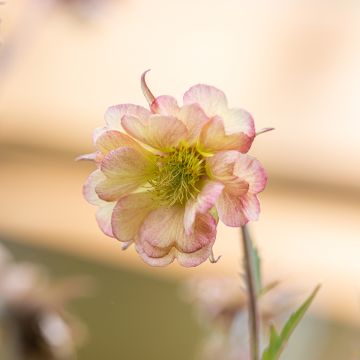

Comments